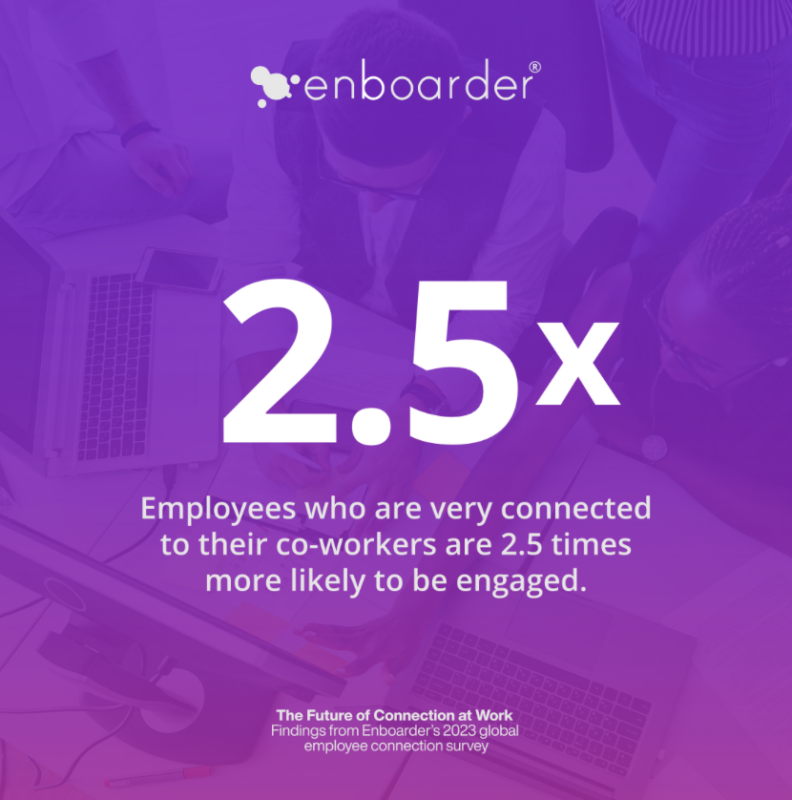Is Employee Connection a Better Metric Than Employee Engagement?
Employee engagement has been the way we measure the quality of our workplace and culture for years. It’s been the single most common way we measure the emotional connection employees have to the organization and their commitment to its shared goals.
But in the new world of work, has employee engagement outlived its usefulness?
Employee Engagement vs. Employee Connection
We know, we know. Sacrilege, right? But maybe not. It turns out, employee engagement is just one way of measuring our organizational commitment – and maybe not even the best way. As workplaces are taking shape for the post-pandemic age, we’re discovering a new, and possibly more important bellwether: employee connection.
Okay, it’s not exactly new. Gallup has baked connection into their gold standard employee engagement model for years, asking “Do you have a best friend at work?” We know connection to coworkers has always been part of the picture. Our own recent research has also shown that connection and engagement are closely entwined. For instance, employees who feel connected are 2.5x were more likely to agree that their workplace keeps them engaged and 2.5x more likely to be motivated to go above and beyond in their job responsibilities.

But maybe it’s time to take a closer look at employee connection on its own merits. Because connection is not just about commitment to the work. It’s about genuine human interaction, understanding, and a sense of belonging. It’s about working hard not just for the organization, but for the people around us. The difference is subtle, yet profound.
Human connection metrics might not supersede engagement right away – but they can certainly give engagement a run for its money. We can think of engagement as an important starting point. It made companies ask: “Is our team motivated? Are they aligned with our goals?” This was an important move in seeing employees as the heart of an organization, and not just gears in a machine. But we’ve largely made this transition now. If there’s one thing the recent pandemic and Great Resignation taught us, it is that companies who see their workforce as a collection of people are more resilient.
The hard truth is that the last few years have brought a backlash against the assumptions that underpin engagement – from employees themselves. Quiet quitting, bare-minimum Mondays, lazy girl jobs, and other hashtags trended, channeling employees’ concerns about burnout and overwork – and sharpening employers’ anxieties about the fate of engagement.
After all, if we only measure our ability to succeed by employee discretionary effort, and going “above and beyond” – what happens when those employees let us know they don’t want to deliver more hours than they’re paid for?
Why Employee Connection Matters
That’s where employee connection might be a more reliable measure of actual effort and commitment. Connection also moves past mere alignment with company goals and dives into the realm of shared experiences, mutual understanding, and the feeling of being truly “seen” and valued in a workspace. It’s about the emotional and human elements that bond a team, making them more than just coworkers.
Why does this connection matter so much? The answer lies in the intrinsic human need for belonging. This isn’t a new-age corporate philosophy, but rather, a fundamental human necessity. Psychological theories, like Maslow’s hierarchy of needs, have long placed belonging as central to our well-being, just above safety and basic physiological needs. Feeling connected at work goes a long way in preventing feelings of isolation, which is crucial in an era where remote work and digital communication can sometimes create unintentional barriers.
Here’s the real clincher: Connection is not just a “feel-good” factor. It has tangible, bottom-line benefits. When employees are connected as people, they deliver better work, no matter how many hours they log. They collaborate better, understanding each other’s strengths and nuances, leading to cohesive teams that drive results.
Read more about the ROI of Human Connection in this e-book. 📖

Employees who feel connected are also intrinsically motivated. They tend to outperform their counterparts, bringing innovation and efficiency to the table. Their work output is directly tied to their sense of belonging, as they care more about their tasks when they care more about their teams and the people they work with.
A strong sense of connection is a potent antidote to high turnover rates -something we usually look to engagement to measure. Employees stay where they feel engaged – but they more often stay where they feel understood, valued, and connected.
In this same way, connection links back to almost every metric we traditionally think about as tied to engagement. When employees believe their voices are heard and valued, they’re more likely to voice ideas, leading to a culture of continuous improvement and creativity. And let’s not forget the ripple effect: A connected employee often translates to a satisfied customer, as these employees represent the brand with authenticity and passion.
Perhaps most importantly for new generations of workers, connection leaves room for the idea of working smarter and harder – not longer – in a way that engagement does not.
For organizations keen on cultivating connection, a few strategies can help:
- Open and Direct Communication: Keep channels of communication open. Encourage feedback, opinions, and suggestions. Make sure every employee feels their voice matters.
- Inclusive Events & Team Building: Whether it’s virtual coffee breaks or team retreats, ensure opportunities for employees to get to know each other beyond work.
- Mentoring, Buddies, & Peer Support Systems: Bridge the experience gap. Let newer employees learn from the seasoned ones and vice versa. Connect people on a personal, human level and encourage friendships.
- Recognizing and Celebrating Achievements: Everyone wants to feel valued. Regular recognition can reinforce their importance in the company.
All this might beg the question of how you can actually measure connection. After all, most of us have been doing formal employee engagement surveys for some time now. We’re not suggesting you go cold turkey and throw away your trending metrics, but there are some important things you can do to start baking connection into how you measure and manage organizational culture.
How to Measure Connection
For one, you can start by asking employees about how they connect to each other, using quantitative surveys or qualitative feedback. You can also use a platform like Enboarder® – which helps you to get at these insights, seeing real-time interactions and also deploying nuanced measurement tools.
Whether you decide to swap connection metrics for engagement or not, one thing is clear: it’s no longer enough to merely have an “engaged” workforce. The future lies in fostering deep, meaningful connections, and weaving a tapestry of shared experiences, values, and goals.
Every organization must pause and ask: Are we merely engaging our employees, or are we truly connecting with them? The difference between the two might just be the key to unparalleled success in this dynamic work environment.
We can help you with taking that next step in fostering employee connection. Explore how Enboarder can help elevate your organization’s journey. Reach out to us today for a tour of the platform.